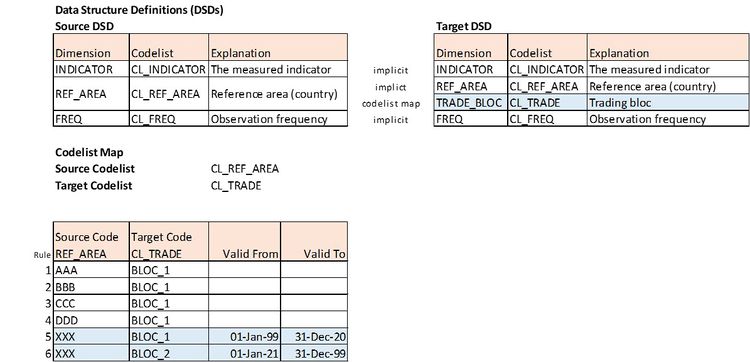Difference between revisions of "Mapping behaviour using item validity"
(→Use Cases) |
(→Use Cases) |
||
| Line 7: | Line 7: | ||
==Use Cases== | ==Use Cases== | ||
| − | The main use case for setting Validity Periods on Codelist Maps is to forward schedule changes | + | The main use case for setting Validity Periods on Codelist Maps is to forward schedule changes to the behaviour of a map with respect to how classifications are transformed. By way of an example, consider a map that translates a country code dimension into a trading bloc dimension. If it is known that a particular country will move to a different trading bloc on a particular date, two separate rules can be created, one describing the country-bloc mapping before the move, the other describing the mapping after. |
| + | This is illustrated in the example below: | ||
::[[File:Codelist mapping example with validity periods.jpg|frameless|750px]] | ::[[File:Codelist mapping example with validity periods.jpg|frameless|750px]] | ||
| + | |||
| + | A DSD with INDICATOR, REF_AREA and FREQ dimensions is transformed into a similar DSD with the addition of a TRADE_BLOC dimension. When defining the mapping rules, most dimensions can be implicitly mapped (i.e. the dimension value for each series is simply copied from the source dataset to the target dataset). The mapping for the TRADE_BLOC dimension, however, is mapped using a Codelist Map from the REF_AREA dimension. | ||
==Example== | ==Example== | ||
Revision as of 07:47, 21 January 2020
Overview
Fusion Registry's Structure Mapping function allows datasets to be transformed from one structure and classification scheme to another. Mapping of classifications is performed using Codelist Maps which define how Codes in one Codelist map to those in another.
When defining Codelist Maps, multiple mapping rules can be specified for each Code with a Validity Period for each. The Validity Period sets the period in real time when the rule will be active. Mapping rules with Validity Periods are executed if the time at which the mapping is performed falls within the time range specified. Conversely, rules without Validity Periods are always active and are executed irrespective of when the mapping is actually performed.
Use Cases
The main use case for setting Validity Periods on Codelist Maps is to forward schedule changes to the behaviour of a map with respect to how classifications are transformed. By way of an example, consider a map that translates a country code dimension into a trading bloc dimension. If it is known that a particular country will move to a different trading bloc on a particular date, two separate rules can be created, one describing the country-bloc mapping before the move, the other describing the mapping after. This is illustrated in the example below:
A DSD with INDICATOR, REF_AREA and FREQ dimensions is transformed into a similar DSD with the addition of a TRADE_BLOC dimension. When defining the mapping rules, most dimensions can be implicitly mapped (i.e. the dimension value for each series is simply copied from the source dataset to the target dataset). The mapping for the TRADE_BLOC dimension, however, is mapped using a Codelist Map from the REF_AREA dimension.
